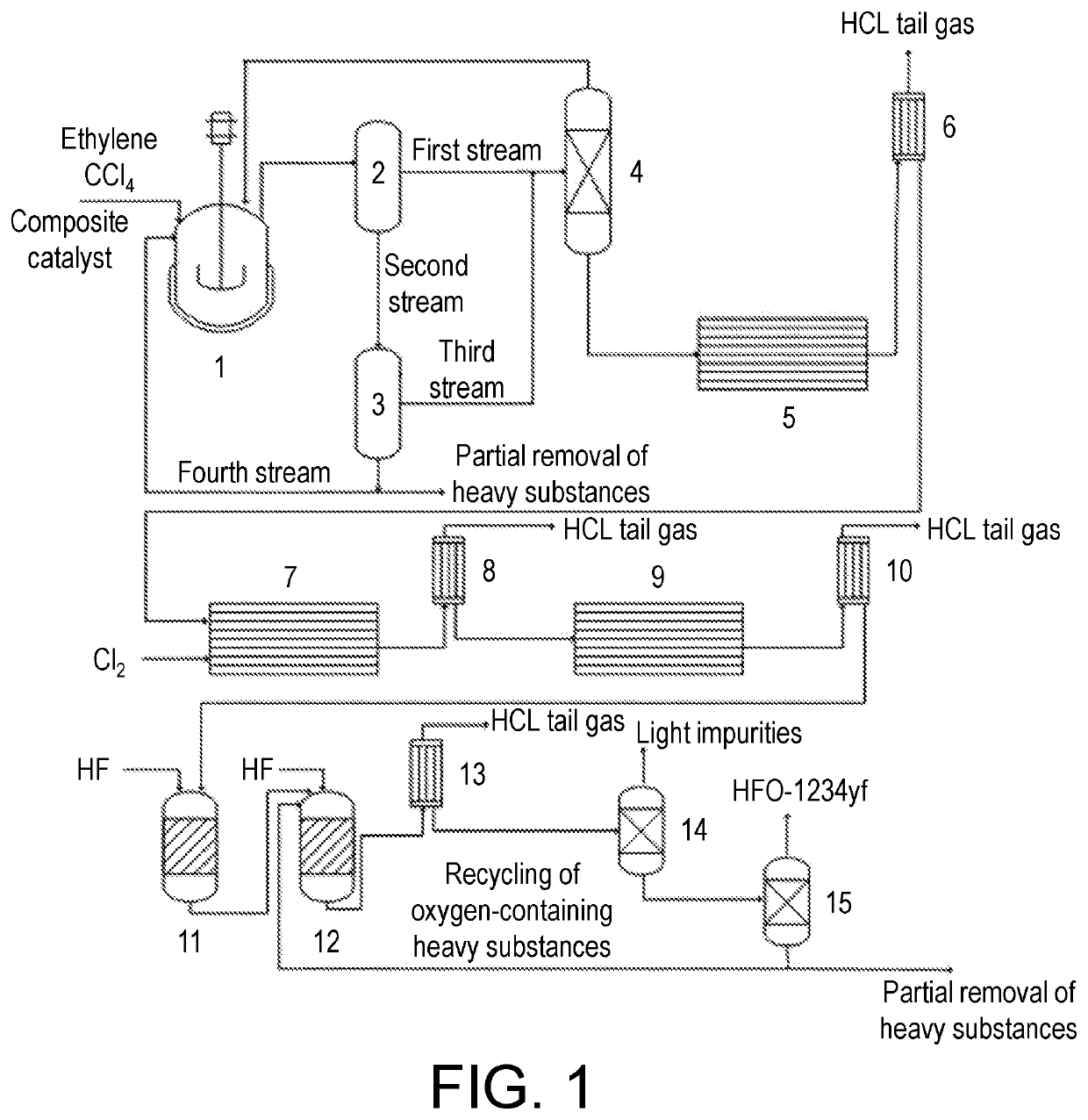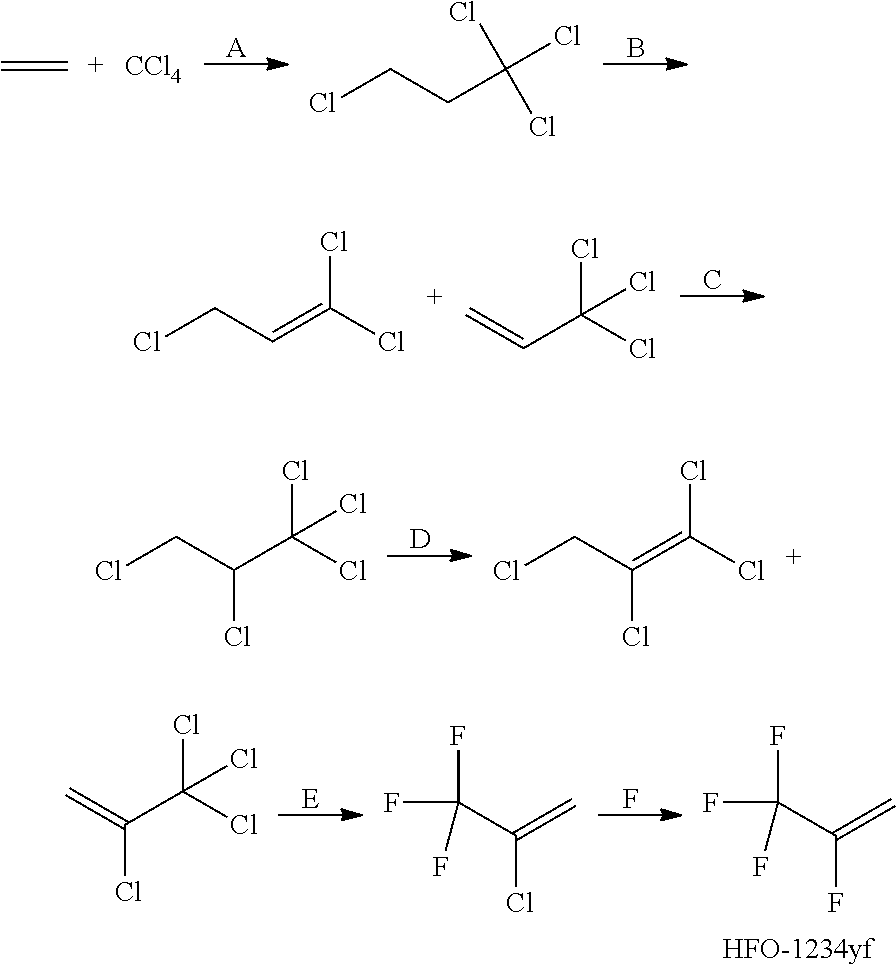Method for continuous preparation of 2,3,3,3-tetrafluoropropene
- Summary
- Abstract
- Description
- Claims
- Application Information
AI Technical Summary
Benefits of technology
Problems solved by technology
Method used
Image
Examples
example 1
[0065](1) The mass ratio of carbon tetrachloride to a composite catalyst was 49:1; the composite catalyst was composed of, by weight: 1.0 part of a co-catalyst tributyl phosphate and 1.0 part of a catalyst (200-mesh iron powder); the reaction temperature was 90° C., the molar ratio of carbon tetrachloride to ethylene was 1, the residence time is 120 min, and the system pressure was maintained at 1.0 Mpa; sampling analysis was carried out; calculated on the basis of ethylene, the conversion rate was 90%, and the HCC-250fb selectivity was 96.5%;
[0066](2) the reaction product obtained in step (1) was introduced into a first membrane separator (with a membrane area of 0.4 m2) for separation through a pump at a flow rate of 70 ml / min to obtain a first stream (based on sampling analysis, including, by weight, 87 parts of carbon tetrachloride, 10 parts of HCC-250fb, 2.0 parts of tetrachloroethylene, and 1.0 part of hexachloroethane) and a second stream (based on sampling analysis, includin...
example 2
[0074](1) The mass ratio of carbon tetrachloride to a composite catalyst was 63.5:1; the composite catalyst was composed of, by weight: 0.75 parts of a co-catalyst tributyl phosphate and 0.8 parts of a catalyst (200-mesh iron powder); the reaction temperature was 110° C., the molar ratio of carbon tetrachloride to ethylene was 2, the residence time was 90 min, and the system pressure was maintained at 0.7 Mpa; sampling analysis was carried out; calculated on the basis of ethylene, the conversion rate was 99%, and the HCC-250fb selectivity was 95.0%;
[0075](2) the reaction product obtained in step (1) was introduced into a first membrane separator (with a membrane area of 0.4 m2) for separation to obtain a first stream (based on sampling analysis, including, by weight, 88 parts of carbon tetrachloride, 9 parts of HCC-250fb, 2.5 parts of tetrachloroethylene, and 0.5 parts of hexachloroethane) and a second stream (based on sampling analysis, including, by weight, 90.5 parts of HCC-250fb...
example 3
[0083](1) The mass ratio of carbon tetrachloride to a composite catalyst was 99:1; the composite catalyst was composed of, by weight: 0.5 parts of a co-catalyst tributyl phosphate and 0.5 parts of a catalyst (200-mesh iron powder); the reaction temperature was 120° C., the molar ratio of carbon tetrachloride to ethylene was 4, the residence time was 60 min, and the reaction pressure was maintained at 0.5 Mpa; sampling analysis was carried out; calculated on the basis of ethylene, the conversion rate was 99%, and the HCC-250fb selectivity was 95.0%;
[0084](2) the reaction product obtained in step (1) was introduced into a first membrane separator (with a membrane area of 0.4 m2) for separation through a pump at a flow rate of 10 ml / min to obtain a first stream (based on sampling analysis, including, by weight, 89 parts of carbon tetrachloride, 8 parts of HCC-250fb, 2.5 parts of tetrachloroethylene, and 0.5 parts of hexachloroethane) and a second stream (based on sampling analysis, inc...
PUM
| Property | Measurement | Unit |
|---|---|---|
| Temperature | aaaaa | aaaaa |
| Temperature | aaaaa | aaaaa |
| Temperature | aaaaa | aaaaa |
Abstract
Description
Claims
Application Information
 Login to View More
Login to View More - R&D
- Intellectual Property
- Life Sciences
- Materials
- Tech Scout
- Unparalleled Data Quality
- Higher Quality Content
- 60% Fewer Hallucinations
Browse by: Latest US Patents, China's latest patents, Technical Efficacy Thesaurus, Application Domain, Technology Topic, Popular Technical Reports.
© 2025 PatSnap. All rights reserved.Legal|Privacy policy|Modern Slavery Act Transparency Statement|Sitemap|About US| Contact US: help@patsnap.com


